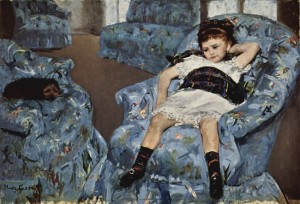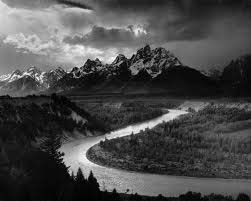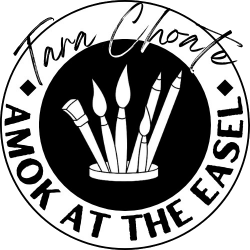Today’s post is brought to you by the seemingly random powers that rule the internet.
Random event 1
A couple days ago I liked a Facebook post that had a nice piece of art in it. This was apparently a foolish move, because I have become embroiled in a plot to “occupy Facebook with art” and was assigned an artist to post about: Mary Cassat.
While not my favorite impressionist (Monet with Renoir a tight second) she’s in a nose-to-nose race with Degas (I love Degas’ racehorses, but hate his misogyny) for third.
Like Renoir, Cassat specialized in painting people, specifically women and children in intimate, home-centered environments. Because of her subject matter, she did not achieve the same recognition as other Impressionists, though that has largely changed in recent history.

Arguably my favorite painting of Cassat’s is “Little Girl in a Blue Armchair.” I love the evocative pose of the little girl, the curled up dog, and the startling blue of the armchairs. This painting shows something both innocent and frustrated.
Random event 2
Each day I get a word from the Oxford English Dictionary Online Word of the Day:
paysagist, n.
[‘ A landscape artist.’]
Pronunciation: Brit. /ˈpeɪzədʒɪst/, U.S. /ˈpeɪzədʒəst/, /ˌpeɪ(i)zɑˈʒist/
This definition was followed by several key usages, one of which mentioned Ansel Adams.
“Ansel Easton Adams (February 20, 1902 – April 22, 1984) was an American photographer and environmentalist. His black-and-white landscape photographs of the American West, especially Yosemite National Park, have been widely reproduced on calendars, posters, and in books.[1]” http://en.wikipedia.org/wiki/Ansel_Adams
I think there are few people who have viewed Ansel Adams work that aren’t moved by it.

From the series Ansel Adams Photographs of National Parks and Monuments, compiled 1941 – 1942, documenting the period ca. 1933 – 1942.
What’s unique about Adams is that, like the Impressionists, he was taking a 90 degree turn from what everyone else was doing at the time. While other photographers were concentrating on capturing images of humans, Adams documented the landscape; and he did it so well that he changed the world.
He changed the world just by documenting was what around him that he liked.
Random event 3
Today I got another word from OED:
philhippic, adj.
[‘ Fond of or interested in horses.’]
If this word was a tattoo, I would have immediately run for the nearest needle. I have attached myself to this word because, well, IT’S SO ME!
As I merrily contemplated ways to bring this word more into my life, I got to thinking about Mary Cassat and Ansel Adams. Did they have a word they associated with this strongly?
That got me to thinking about how much art (and everything else) has to do with what you are thinking about and paying attention to.
As an emerging artist, I’m still trying to decide what I am going to pay attention to. But based on how strongly I tuned into this word, I am reminded that horses will figure prominently.
